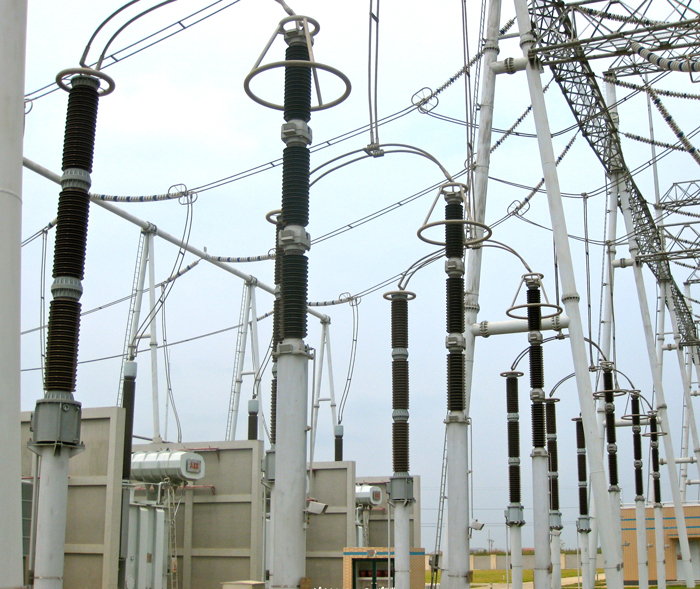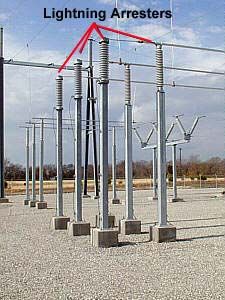Lightning arresters are installed in substations to protect equipment from damage due to lightning strikes. The arresters are connected to the ground and the equipment, and they divert the electrical current from the lightning strike away from the equipment.
A lightning arrester is a device used to protect electrical equipment from damage by lightning strikes. It is installed in electrical substations, where it diverts the potentially damaging effects of a lightning strike away from sensitive equipment.
The installation of a lightning arrester requires careful planning and execution.
The first step is to determine the best location for the device. The next step is to install the grounding system that will be used to dissipate the effects of a lightning strike. Finally, the actual lightning arrester itself must be installed and connected to the grounding system.
Lightning arresters are an important part of any electrical substation. They provide protection against one of nature’s most destructive forces, and can help keep your equipment safe in the event of a thunderstorm.
Lightning Arrester Types for Building
The type of lightning arrester installed on a building depends on the structure of the building, the level of protection required, and the environment in which the building is located. The most common types of lightning arresters for buildings are air-terminal devices, down conductors, and ground rods.
Air-terminal devices are placed at or near the highest point of a structure and provide a direct path to ground for Lightning flashes.
Air-terminal devices come in various shapes and sizes and can be made from different materials including copper, aluminum, or stainless steel. The size and material used will depend on the height of the structure and its location. Down conductors are used to connect air-terminal devices to grounding systems.
They are typically made from copper or aluminum cable and must be able to withstand high temperatures and mechanical stresses. Ground rods are driven into the earth to provide an electrical connection between the grounding system and the earth. Ground rods come in various sizes and lengths depending on their use.
Lightning Arrester in Substation
A lightning arrester is a device installed at the substation to protect equipment from damage due to lightning. The way it works is by allowing the current from the lightning strike to flow through the arrester to the ground instead of through the equipment.
One of the main benefits of having a lightning arrester is that it can help prevent fires.
This is because when there is a sudden surge of electricity, such as from a lightning strike, it can cause components in electrical equipment to overheat and start a fire. By diverting this surge of electricity away from sensitive equipment, the risk of fire is greatly reduced.
Another benefit of having a lightning arrester is that it can help prolong the life of your electrical equipment.
When there is a sudden surge of electricity, components in electrical equipment can be damaged or even destroyed. By diverting this surge away from your equipment, you can help protect it from being damaged or destroyed prematurely.
If you have an electrical substation, then installing a lightning arrester is something you should definitely consider doing.
It can provide many benefits and help keep your equipment safe from damage due to lightning strikes.
Lightning Arrester for Building
A lightning arrester is a device installed on the exterior of buildings that protects against damage from lightning strikes. Lightning arresters work by providing a path for the electrical current from a lightning strike to travel through, instead of through the building itself. This prevents the electrical current from damaging the building and its contents.
Lightning Arrester Installation Guide Pdf
A lightning arrestor is a device used to protect electrical equipment from damage due to lightning strikes. Arrestors are also known as surge suppressors or surge protection devices (SPDs). They work by providing a low impedance path to ground for the lightning strike current, thus preventing the voltage from rising to a level that could damage the equipment.
Most homes and businesses in areas with frequent thunderstorms or other high risk of lightning strikes have some type of SPD installed on their electrical systems. The most common type of arrestor is the air gap, which is simply a gap in an electrically conductive path that provides an easy route for the current to flow to ground. Other types of arrestors include metal oxide varistors (MOVs), gas discharge tubes (GDTs), and silicon avalanche diodes (SADs).
Arrestors are typically installed at points where external cables connect to buildings, such as at the service entrance panel or meter base. They may also be installed inside buildings near sensitive electronic equipment, such as computers and TVs. In some cases, multiple SPDs may be connected in series or parallel to provide greater protection.
When installing arrestors, it is important to follow the manufacturer’s instructions carefully. The National Electrical Code (NEC) also has specific requirements for lighting protection systems, including arrestors (Article 280). Improper installation can result in damage to the equipment or even fires.
Lightning Arrester Specification
A lightning arrester is a device that is used to protect electrical equipment from damage due to lightning strikes. The device works by dissipating the electrical charge from a lightning strike before it can reach the protected equipment. Lightning arresters are typically installed at the point where an electrical circuit enters a building or structure, such as at the service entrance panel.
When selecting a lightning arrester for your application, it is important to consider the following factors:
• Voltage rating: The voltage rating of a lightning arrester must be equal to or greater than the maximum voltage that could be present on the protected circuit.
• Current Rating: The current rating of a lightning arrester must be equal to or greater than the maximum current that could be present on the protected circuit during a fault condition.
• Frequency: Most lightning arresters are designed for use with alternating current (AC) power systems. However, some arresters are also available for use with direct current (DC) power systems. Be sure to select an arrester that is compatible with your power system’s frequency.
Application of Lightning Arrester
Lightning Arrester, also known as surge arrestor, is an electrical device used to protect electric equipment from damage caused by lightning strikes. It is installed between the service entrance and the main distribution panel in homes and commercial buildings. A properly installed and maintained Lightning Arrester can provide protection against damage from lightning for many years.

Credit: www.inmr.com
How are the Lightning Arrestors Installed in a Substation?
In order to protect a substation from lightning strikes, arrestors must be installed at strategic points throughout the facility. These devices work by dissipating the electrical charge of a strike before it can cause damage to sensitive equipment. Proper installation of arrestors is critical to ensuring that they will function as intended in the event of a strike.
There are three main types of arrestors: air gap, down conductor, and ground wire. Air gap arrestors are placed on top of buildings or other structures and use the air gap between them as an insulator. Down conductors are placed along the side of buildings or other structures and allow the charge to be conducted away from sensitive equipment.
Ground wires are buried around the perimeter of a substation and provide a path for the charge to dissipate into the ground.
The specific location of each type of arrester depends on the layout of the substation. However, in general, air gap arrestors are placed near transformer banks, down conductors are placed near switchgear, and ground wires are placed around the perimeter of the property.
In some cases, multiple Arrestor types may be used in combination to provide comprehensive protection against lightning strikes.
How Do You Install a Lightning Arrester?
Lightning arresters are devices that are installed on buildings and other structures to protect them from damage caused by lightning strikes. They work by intercepting the electrical current from a lightning strike and dissipating it into the ground, thereby preventing it from causing damage to the structure. Lightning arresters must be installed by qualified professionals in order to ensure that they are properly connected and functioning correctly.
What is Lightning Arrester in Electrical Substation?
A lightning arrester is an electrical device used to protect equipment from damage caused by lightning strikes. It is installed at the point where a lightning strike is most likely to occur, such as at the top of a tall structure or on utility poles. The Lightning Arrester diverts the damaging effects of a lightning strike away from sensitive equipment and into the ground.
Lightning arresters are devices that are intended to protect buildings and other structures from damage due to lightning strikes. They work by intercepting the charge from a lightning bolt and then dissipating it harmlessly into the ground. These devices are typically installed on tall structures such as skyscrapers or communication towers, but they can also be used on smaller buildings and homes.
When a thunderstorm approaches, there is an increase in static electricity in the air. This static electricity is produced by collisions between ice particles and water droplets within the storm clouds. As these charged particles collide, they create an electric field around the thunderstorm cloud.
When this electric field becomes strong enough, it causes electrons to flow from the cloud towards the ground. This flow of electrons creates a giant spark of electricity known as a lightning bolt.
A typical lightning bolt contains about one billion volts of electricity and can reach temperatures hot enough to melt metal.
When this massive amount of energy hits something like a building or power line, it can cause severe damage or even start fires. That’s why it’s so important to have devices like Lightning Arresters in place – to protect against this type of damage.
Lightning arresters work by providing a path for the current from a lightning strike to flow into the ground rather than through whatever structure they’re protecting.
By doing so, they reduce or eliminate any damage that might otherwise be caused by the strike. Most modern arresters contain special components that allow them to safely dissipate this huge amount of energy without being damaged themselves
While most people think of them as big rods sticking out of buildings during thunderstorms, not all Lightning Arresters are visible from the ground level.
Where is Surge Arrester Placed in Substation?
A surge arrester is an electrical device used to protect against voltage spikes. It is typically placed at the point where a power line enters a substation, in order to protect the equipment inside from damage.
Difference between a lightning rod and a lightning arrester (34 – Electricity Distribution)
Conclusion
The installation of a lightning arrester is a critical component in any substation. Without one, the potential for damage from a lightning strike is greatly increased. There are many different types and sizes of arresters available on the market, so it is important to select the right one for your needs.
The most common type of arrester used in substations is the air gap arrester. This type of device uses an air gap to create a barrier between the conductor and the ground, which prevents sparks from jumping across and causing damage. There are also devices known as surge diverters or suppressors that can be used in conjunction with an air gap arrester to provide additional protection.



